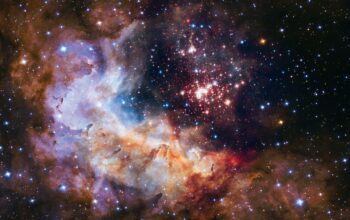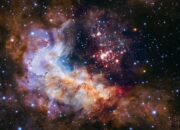Quark gluon plasma (QGP) represents a unique state of matter that existed in the universe microseconds after the Big Bang. This exotic phase of matter is characterized by the presence of quarks and gluons—fundamental constituents of matter—that are typically confined within protons and neutrons. The study of QGP not only illuminates the thermal conditions of the early universe but also deepens our understanding of quantum chromodynamics (QCD), the theory describing the strong interactions among quarks and gluons.
To fully appreciate the complexities of quark gluon plasma, it is imperative to delve into several interrelated topics: the fundamental constituents of matter, the conditions under which QGP arises, the experimental attempts to recreate this state, and the implications of these findings for both cosmology and particle physics.
1. The Building Blocks of Matter
Quarks and gluons are the elemental particles underlying the Standard Model of particle physics. Quarks come in six flavors: up, down, charm, strange, top, and bottom. These quarks combine to form baryons (such as protons and neutrons) and mesons (composed of quark-antiquark pairs). Gluons, on the other hand, serve as the force carriers of the strong nuclear force, binding quarks together. Importantly, at ordinary temperatures and energy densities, quarks and gluons are not found in isolation; they are perpetually confined within hadrons due to the property known as color confinement.
The strong force, mediated by gluons, is one of nature’s four fundamental forces. It is significantly more potent than electromagnetism at short ranges, which contributes to the stability of atomic nuclei. However, under extreme conditions, such as those present in the early universe or in high-energy collisions in particle accelerators, the fabric of space-time itself begins to unravel, allowing quarks and gluons to become deconfined, thus leading to the formation of QGP.
2. Conditions for the Emergence of Quark Gluon Plasma
QGP is theorized to exist at extraordinarily high temperatures and energy densities. These conditions are thought to have been prevalent in the microseconds following the Big Bang, when the universe was a hot, dense soup of quarks, antiquarks, and gluons. The critical temperature for creating QGP is estimated to be around 2 trillion degrees Celsius (or about 2 trillion Kelvin), a temperature far beyond the reach of conventional matter.
In terrestrial laboratories, such conditions can be simulated using large particle colliders, such as the Large Hadron Collider (LHC) at CERN or the Relativistic Heavy Ion Collider (RHIC) at Brookhaven National Laboratory. In these experiments, heavy ions, such as gold or lead nuclei, are accelerated to near-light speeds and smashed together. The energy density produced in such collisions can be sufficient to briefly allow quarks and gluons to exist as an uncontained state—effectively creating a form of QGP.
3. Experimental Evidence of QGP
The experimental search for quark gluon plasma began in earnest in the late 1990s. RHIC was the first to successfully produce and detect signs of QGP in 2000. The experiments revealed unique signatures characteristic of this state of matter, including the suppression of high-energy particles produced in the collisions, known as “jet quenching.” This phenomenon occurs when the energy of fast-moving quarks or gluons is lost to interactions with the dense medium of QGP, resulting in reduced particle production at high momenta.
In subsequent years, the LHC has further investigated the properties of QGP, yielding additional insights into its characteristics. Measurements of elliptic flow, which demonstrates how the initial asymmetric spatial configuration of the colliding nuclei affects the resulting particle distribution, have provided crucial data, supporting theories about the fluid-like behavior of QGP.
Furthermore, collective behavior and thermalization indicate that QGP behaves not merely as a gas of free particles but as a near-perfect fluid. This extraordinary fluidity offers profound implications about the interactions and dynamical equilibrium of strongly coupled systems.
4. Theoretical Implications and Significance
The exploration of quark gluon plasma extends beyond mere curiosity; it poses critical questions regarding our understanding of the universe. One pivotal area of investigation is how the properties of QGP inform our comprehension of the early universe’s evolution. Insights gathered from QGP can elucidate phenomena related to nucleosynthesis, the formation of matter, and the transition from a quark-gluon state to the hadronic matter we observe today.
Moreover, the findings bolster the theoretical framework of quantum chromodynamics, offering empirical evidence that reinforces the predictions made by QCD. Understanding how quarks and gluons interact under extreme conditions can shed light on the fundamental forces governing all matter and provide clues in the search for unifying theories in physics, especially those that bridge quantum mechanics and gravity.
5. Future Directions
The ongoing study of quark gluon plasma remains a vibrant and evolving field of research. Future experiments aim to further explore the properties of this state, potentially uncovering new states of matter or novel phenomena. Advances in detector technology and experimental techniques will facilitate more precise measurements, allowing researchers to probe deeper into the properties of the QGP fluid, including its temperature, density, and viscosity.
In summary, quark gluon plasma stands as a cornerstone in the study of high-energy physics and cosmology. Understanding its properties and behaviors not only offers tantalizing glimpses into the conditions prevailing in the early universe but also enhances our understanding of the fundamental forces that shape our reality. As our experimental and theoretical frameworks continue to evolve, so too will our knowledge of the dense, primordial soup that gave rise to all matter we see today.












